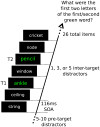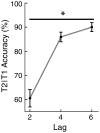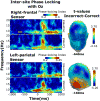Pre-target oscillatory brain activity and the attentional blink
- PMID: 26341931
- PMCID: PMC4651748
- DOI: 10.1007/s00221-015-4418-2
Pre-target oscillatory brain activity and the attentional blink
Abstract
Reporting the second of two targets within a stream of distracting words during rapid serial visual presentation (RSVP) is impaired when the targets are separated by a single distractor word, a deficit in temporal attention that has been referred to as the attentional blink (AB). Recent conceptual and empirical work has pointed to pre-target brain states as potential mediators of the AB effect. The current study examined differences in pre-target electrophysiology between correctly and incorrectly reported trials, considering amplitude and phase measures of alpha oscillations as well as the steady-state visual evoked potential (ssVEP) evoked by the RSVP stream. For incorrectly reported trials, relatively lower alpha-band power and greater ssVEP inter-trial phase locking were observed during extended time periods preceding presentation of the first target. These results suggest that facilitated processing of the pre-target distracter stream indexed by reduced alpha and heightened phase locking characterizes a dynamic brain state that predicts lower accuracy in terms of reporting the second target under strict temporal constraints. Findings align with hypotheses in which the AB effect is attributed to neurocognitive factors such as fluctuations in pre-target attention or to cognitive strategies applied at the trial level.
Keywords: Attention control; Electroencephalography (EEG); Oscillatory activity; Steady-state visual evoked potential (ssVEP); Visual rapid serial processing.
Conflict of interest statement
Figures






Similar articles
-
Endogenous and rapid serial visual presentation-induced alpha band oscillations in the attentional blink.J Cogn Neurosci. 2014 Jul;26(7):1454-68. doi: 10.1162/jocn_a_00551. Epub 2014 Jan 6. J Cogn Neurosci. 2014. PMID: 24392903
-
An electrophysiological investigation of attentional blink in schizophrenia: separating perceptual and attentional processes.Int J Psychophysiol. 2012 Oct;86(1):108-13. doi: 10.1016/j.ijpsycho.2012.06.052. Epub 2012 Jul 4. Int J Psychophysiol. 2012. PMID: 22771850
-
Sparing and impairing: Emotion modulation of the attentional blink and the spread of sparing in a 3-target RSVP task.Atten Percept Psychophys. 2018 Feb;80(2):439-452. doi: 10.3758/s13414-017-1470-y. Atten Percept Psychophys. 2018. PMID: 29243207
-
Shaping prestimulus neural activity with auditory rhythmic stimulation improves the temporal allocation of attention.Neuroreport. 2016 May 4;27(7):487-94. doi: 10.1097/WNR.0000000000000565. Neuroreport. 2016. PMID: 26986506 Free PMC article.
-
Effect of emotions on temporal attention.Prog Brain Res. 2017;236:287-309. doi: 10.1016/bs.pbr.2017.08.014. Epub 2017 Oct 3. Prog Brain Res. 2017. PMID: 29157417 Review.
Cited by
-
How the visual brain detects emotional changes in facial expressions: Evidence from driven and intrinsic brain oscillations.Cortex. 2019 Feb;111:35-50. doi: 10.1016/j.cortex.2018.10.006. Epub 2018 Oct 16. Cortex. 2019. PMID: 30447483 Free PMC article.
-
Oscillatory brain activity links experience to expectancy during associative learning.Psychophysiology. 2022 May;59(5):e13946. doi: 10.1111/psyp.13946. Epub 2021 Oct 7. Psychophysiology. 2022. PMID: 34622471 Free PMC article.
-
Long-term meditation: the relationship between cognitive processes, thinking styles and mindfulness.Cogn Process. 2018 Feb;19(1):73-85. doi: 10.1007/s10339-017-0844-3. Epub 2017 Nov 7. Cogn Process. 2018. PMID: 29110263
-
Exploring the role of expectations and stimulus relevance on stimulus-specific neural representations and conscious report.Neurosci Conscious. 2019 Aug 21;2019(1):niz011. doi: 10.1093/nc/niz011. eCollection 2019. Neurosci Conscious. 2019. PMID: 31456886 Free PMC article.
-
Pre-stimulus EEG phase coherence predicts visual target detection failures in schizophrenia: A pilot study.Schizophr Res. 2024 Oct;272:112-119. doi: 10.1016/j.schres.2024.08.016. Epub 2024 Aug 29. Schizophr Res. 2024. PMID: 39214021
References
-
- Bradley MM, Lang PJ. Affective norms for English words (ANEW): instruction manual and affective ratings. University of Florida, Center for the Study of Emotion and Attention; Gainesville: 1999.
-
- Brainard DH. The psychophysics toolbox. Spat Vis. 1997;10(4):433–436. - PubMed
Publication types
MeSH terms
Grants and funding
LinkOut - more resources
Full Text Sources
Other Literature Sources

